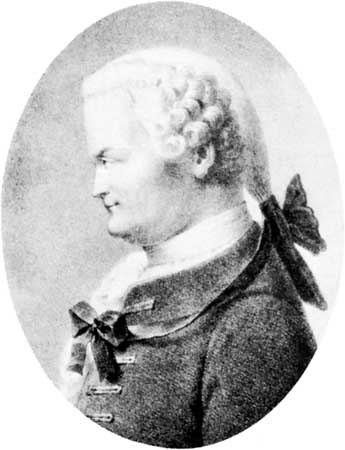Lambert, Johann Heinrich
Swiss-German scientist and philosopher
born August 26, 1728, Mülhausen, Alsace
died September 25, 1777, Berlin, Prussia 【Germany】
 Swiss German mathematician, astronomer, physicist, and philosopher who provided the first rigorous proof that π (pi) (the ratio of a circle's circumference to its diameter) is irrational, meaning that it cannot be expressed as the quotient of two integers.
Swiss German mathematician, astronomer, physicist, and philosopher who provided the first rigorous proof that π (pi) (the ratio of a circle's circumference to its diameter) is irrational, meaning that it cannot be expressed as the quotient of two integers.Lambert, the son of a tailor, was largely self-educated and early in his life began geometric and astronomical investigations by means of instruments he designed and built himself. He worked for a time as a bookkeeper, secretary, and editor. As a private tutor in 1748, he gained access to a good library, which he used for self-improvement until 1759, when he resigned his post to settle in Augsburg. In 1764 he went to Berlin, where he received the patronage of Frederick the Great (Frederick II). His memoir containing the proof that π is irrational was published in 1768. In 1774 at Berlin he became editor of Astronomisches Jahrbuch oder Ephemeriden, an astronomical almanac.
Lambert made the first systematic development of hyperbolic functions. He is also responsible for many innovations in the study of heat and light. The lambert, a measurement of light intensity, was named in his honour. Among his most important works are Photometria (1760; “The Measurement of Light”); Die Theorie der Parallellinien (1766; “The Theory of Parallel Lines”), which contains results later included in non-Euclidean geometry; and Pyrometrie (1779; “The Measurement of Heat”). The Neues Organon (1764; “New Organon”), his principal philosophical work, contains an analysis of a great variety of questions, among them formal logic, probability (probability theory), and the principles of science (science, philosophy of). He also corresponded with Immanuel Kant (Kant, Immanuel), with whom he shares the honour of being among the first to recognize that spiral nebulae (nebula) are disk-shaped galaxies like the Milky Way (Milky Way Galaxy).
- Bahubali
- Bahya ben Joseph ibn Pakuda
- Bahía Blanca
- Bahía Limón
- Bahādur Shah I
- Bahādur Shāh II
- Bahār, Muḥammad Taqī
- Bahāʾ ad-dīn Muḥammad ibn Ḥusayn, al-ʿ Āmilī
- Bahāʾ ad-dīn Muḥammad ibn Ḥusayn Āmilī, al-ʿ
- Bahāʾ al-Dīn
- Bahāʾ al-Dīn Zuhayr
- Bahāʾ Ullāh
- Bahāʾī faith
- Bahāʾī temple
- Bahūtī, al-
- Bai
- Baiae
- Baia Mare
- Baicheng
- Baie-Comeau
- baihua
- Bai Juyi
- Baikal, Lake
- Baikalsky Nature Reserve
- Baikie, William Balfour